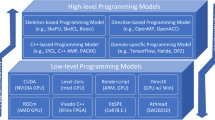Abstract
The need to design and verify architectures to support parallel implementations of declarative languages has led to the development of a novel language, called Paragon, which bridges the gap between the top-level specification of the abstract machine, and its detailed implementation in terms of parallel processes and message passing.
The central technical contributions in this paper are:
-
• The introduction and specification of Paragon, a parallel object-oriented language based on graph rewriting and message passing principles.
-
• An illustration of the approach at work in the design of a parallel supercombinator graph reduction machine.
-
• A sketch proof that this design meets the requirements statement.
Similar content being viewed by others
References
America, P., de Bakker, J., Kok, J. N. and Rutten, J., “Operational Semantics of a Parallel Object-Oriented Language,”Report CS-R8515, Centre for Mathematics and Computer Science, Amsterdam, The Netherlands, 1985.
Anderson, P., Hankin, C. L., Kelly, P. H. J., Osmon, P. E. and Shute, M. J., “COBWEB-2: Structured Specification of a Wafer Scale Supercomputer,” inPARLE, Volume I (de Bakker, J. W., Nijman, A. J. and Treleaven, P. C. eds.),LNCS 258, Springer-Verlag, Berlin, pp. 51–67, 1987.
Anderson, P., “Computer Architecture for Wafer Scale Integration,”Ph.D Thesis, City University.
Aho, A. V., Sethi, R. and Ullman, J. D.,Compilers: Principles, Techniques and Tools, Addison-Wesley, Massachusetts, 1986
Barendregt, H. P., van Eekelen, M. C. D. J., Glauert, J. R. W., Kennaway, J. R., Plasmeijer, M. J. and Sleep, M. R., “Term Graph Rewriting,” inPARLE, Volume II (de Bakker, J. W., Nijman, A. J. and Treleaven, P. C. eds.),LNCS 259, Springer-Verlag, Berlin, pp. 159–176, 1987.
Bolton, D., Hankin, C. L. and Kelly, P. H. J., “Parallel Object-Oriented Descriptions of Graph Reduction Machines,” to appear inFuture Generation Computer Systems, North-Holland.
Dijkstra, E. W., “A Mild Variant of Combinatory Logic,”EWD735, 1980.
Glaser, H. W., Hankin, C. L. and Till, D. R.,Principles of Functional Programming, Prentice Hall International, New Jersey, 1984.
Glauert, J. R. W., Kennaway, J. R. and Sleep, M. R., “DACTL: A Computational Model and Compiler Target Language Based on Graph Reduction,”Report SYS-C 87-03, University of East Anglia, 1987.
Hankin, C. L., Burn, G. L. and Peyton Jones, S. L., “A Safe Approach to Parallel Combinator Reduction,”Theoretical Computer Science, March, 1988.
Hennessy, M.,The Semantics of Programming Language, John Wiley, Chichester, 1990.
Hewitt, C., “Viewing Control Structures as Patterns of Passing Messages,”Artificial Intelligence, 8, 3, pp. 323–364, 1977.
Hughes, R. J. M., “The Design and Implementation of Programming Languages,”Technical Monograph PRG-40, Oxford University Programming Research Group, July, 1983.
Kennaway, J. R. and Sleep, M. R., “Syntax and Informal Semantics of DyNe, a Parallel Language,” inThe Analysis of Concurrent System (Denvir, B. T., Harwood, W. T., Jackson, M. I. and Wray, M. J. eds.),LNCS 207, Springer-Verlag, Berlin, pp. 222–230, 1985.
Milner, R., “A Calculus of Communicating Systems,”LNCS 92, Springer-Verlag, Berlin, 1980.
Milner, R., “Parallel Combinator Reduction Machine,” inThe Analysis of Concurrent Systems (Denvir, B. T., Harwood, W. T., Jackson, M. I. and Wray, M. J. eds.),LNCS 207, Springer-Verlag, Berlin, pp. 120–126, 1985.
Peyton Jones, S. L.,The Implementation of Functional Programming Languages, Prentice Hall International, New Jersey, 1987.
Plotkin, G. D., “A Structural Approach to Operational Semantics,”Technical Report FN-19, Aarhus, Denmark, 1981.
Shapiro, E. and Takeuchi, A., “Object Oriented Programming in Concurrent Prolog,”New Generation Computing, 1, pp. 25–48, 1983.
Turner, D. A., “Miranda: A Non-Strict Functional Language with Polymorphic Types,” inFunctional Programming Languages and Computer Architecture (Jouannaud, J. P. ed.),LNCS 201, Springer-Verlag, Berlin, pp. 1–16, 1985.
Weste, N., et al., “The Symbolics Ivory Design and Verification Strategy,” inIEEE International Conference on Computer Design: VLSI in Computers and Processors, 1987.
Author information
Authors and Affiliations
Additional information
Partially funded by ESPRIT BRA 3074: SemaGraph
About this article
Cite this article
Bolton, D., Hankin, C. & Kelly, P. An operational semantics for Paragon: A design notation for parallel architectures. New Gener Comput 9, 171–197 (1991). https://doi.org/10.1007/BF03037642
Received:
Revised:
Issue Date:
DOI: https://doi.org/10.1007/BF03037642




